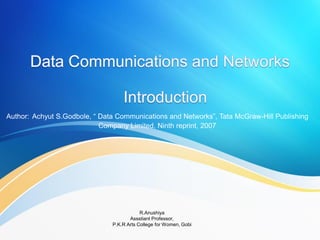Data Communication and Network chapter 1- introduction
- 1. R.Anushiya Assstiant Professor, P.K.R Arts College for Women, Gobi Author: Achyut S.Godbole, “ Data Communications and Networks”, Tata McGraw-Hill Publishing Company Limited, Ninth reprint, 2007
- 2. Introduction to DCN Fundamental Concept Data Communications Protocols Standards Standard Oganizations Signal Propagation Analog and digital signals
- 3. DATA?
- 4. Data generally are defined as information that is stored in digital form
- 6. Communications is the process of transferring digital information between two or more points
- 8. Interconnecting of computer systems that used for transferring messages from one place to other
- 10. Characteristics 1. Correct delivery. The system must deliver data to the correct destination. Data must be received by the intended device or user 2. Accurate delivery. The system must deliver the data accurately. 3. Timely delivery. The system must deliver data in a timely manner. Data delivered late are useless
- 11. Components 1. Message. The message is the information (data) to be communicated. Popular forms of information include text, numbers, pictures, audio, and video. 2. Sender. The sender is the device that sends the data message. It can be a computer, workstation, telephone handset, video camera, and so on. 3. Receiver. The receiver is the device that receives the message. It can be a computer, workstation, telephone handset, television, and so on. 4. Transmission medium. The transmission medium is the physical path by which a message travels from sender to receiver. Some examples of transmission media include twisted-pair wire, coaxial cable, fiber-optic cable, and radio waves 5. Protocol. A protocol is a set of rules that govern data communications. It represents an agreement between the communicating devices.
- 12. Protocol is a set of rules The sender and receiver, the two parties must agree on a common set of rules It defines by Syntax (What to communicate) – Structure of data Semantics (How to Communicate)- Both are in same network Timing (When to Communicate) – Transmission time
- 13. An association of organizations, governments, manufacturers and users form the standards organizations and are responsible for developing, coordinating and maintaining the standards. They are classified as Standard creation committees Forums Regulatory Agencies
- 14. 1. International Standard Organization (ISO) 2. International Telecommunications Union- Telecommunication Sector (ITU-T) 3. Institute of Electrical and Electronics Engineers (IEEE) 4. American National Standards Institute (ANSI) 5. Electronics Industry Association (EIA)
- 15. • User groups, students, industry perspective, experts come together and setup a group to address the various issues and concerns of data communications technology
- 16. • FCC (Federal Communications Commission) is a government appointed agencies • This helps to protect general communication services as radio, television and wired communication















